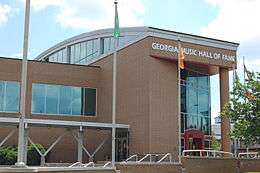Georgia Music Hall of Fame
The Georgia Music Hall of Fame was located in downtown Macon, Georgia, United States, from 1996 until it closed in 2011.[1] The Hall of Fame preserved and interpreted the state's musical heritage through programs of collection, exhibition, education and performance; it attempted to foster an appreciation for Georgia music and tried to stimulate economic growth through a variety of dynamic partnerships and initiatives statewide. The Hall of Fame closed due to low attendance and reduced state funding.[2][3]
 Georgia Music Hall of Fame building | |

| |
| Established | September 22, 1996 |
|---|---|
| Dissolved | June 12, 2011 |
| Location | Macon, Georgia, United States |
| Type | Hall of fame |
| Website | georgiamusicmag |
Mercer University purchased the former Hall of Fame building in June 2012; the university will use the building for expanded programs within its School of Medicine.[4]
Exhibits
The Georgia Music Hall of Fame's permanent exhibit space was designed to resemble a Georgia town where venues such as the Jazz and Swing Club, Vintage Vinyl and Rhythm & Blues Revue house artifacts, interpretive text and audio visual elements. Temporary exhibits included "Keeps Calling Me Home: A Gram Parsons Retrospective", "Let Freedom Sing: Music and the Civil Rights Movement" and '"Otis Redding: I've Got Dreams to Remember", named "Museum Exhibition of the Year" in 2008 by the Georgia Association of Museums and Galleries.[5]
Education
Education was at the core of the Georgia Music Hall of Fame's mission. The Billy Watson Music Factory served children grades pre-K through elementary by encouraging the exploration of musical concepts like rhythm, melody and composition in a hands-on learning environment. MIKE (Music in Kid's Education) provided a series of programs offering live music performances and music instruction opportunities throughout the year.
Georgia Music Magazine
The Georgia Music Hall of Fame Foundation published Georgia Music Magazine quarterly as both the official museum magazine and an in-depth look at Georgia music. The state's legends, landmarks and unsung heroes were explored through features, historical articles, news and reviews.
History
Founding
The Georgia Music Hall of Fame's institutional history began in 1978 when the Georgia General Assembly created the Senate Music Recording Industry Committee to study the economic impact of the state's music industry and to explore ways to promote Georgia music and attract music businesses to the state.[6] In 1979, the Committee developed a Georgia Music Hall of Fame program honoring Georgia musicians who have made significant contributions to the music industry, with Ray Charles and music publisher Bill Lowery named the first inductees on Sept. 26, 1979.
Physical facility
Owing much to the vision of then Lt. Governor Zell Miller, the Committee also endeavored to create a public museum and archive to document the state's music heritage and serve as a cultural heritage destination. In 1990, the Georgia Music Hall of Fame Authority was created as an instrumentality of the State of Georgia and a public corporation with the stated corporate purpose and general nature: 1) to construct and maintain a facility to house the Georgia Music Hall of Fame; 2) to operate, advertise and promote the Georgia Music Hall of Fame; and 3) to promote music events at the facility and throughout the state. On Sept. 22, 1996, the Georgia Music Hall of Fame opened as a 43,000-square-foot (4,000 m2) facility housing a main exhibit hall, a retail store, the Zell Miller Center for Georgia Music Studies, an administrative wing, a classroom and a reception room. In 1999, the second phase of the museum, The Billy Watson Music Factory, an interactive and interpretive exhibit space for pre-K through elementary students, opened.
The hall was closed on June 12, 2011 due to lack of attendance, and the collection donated to the University of Georgia Special Collections Libraries.[7] The exhibits are now being housed at the University of Georgia, Georgia State University, the University of West Georgia, and in private collections.[8]
Inductees
.jpg)
See also
References
- "Georgia Music Hall of Fame | New Georgia Encyclopedia". Georgiaencyclopedia.org. 2013-08-13. Retrieved 2014-07-14.
- "Georgia Music Hall Of Fame Closing". Gpb.org. 2011-05-24. Retrieved 2014-07-14.
- Williams, Dave (2012-02-23). "Closed Georgia Music Hall site 'surplus property'".
- Ramati, Phillip. "State approves sale of music hall to Mercer | Morning Update". Macon.com. Retrieved 2014-07-14.
- "Georgia Music Hall of Fame Earns Award for Otis Redding Exhibition | Georgia Department of Economic Development". www.georgia.org. Georgia Department of Economic Development. Retrieved 25 June 2019.
- "Georgia Music Hall of Fame | New Georgia Encyclopedia". Georgiaencyclopedia.org. 2013-08-13. Retrieved 2014-07-14.
- "Georgia Music Hall of Fame Collection". Georgia Music Foundation. Retrieved September 5, 2019.
- "Georgia Music Hall of Fame | New Georgia Encyclopedia". Georgiaencyclopedia.org. 2013-08-13. Retrieved 2014-07-14.
- Ruggieri, Melissa (July 20, 2015). "Gregg Allman, Drivin' N Cryin', Sam Moore among 2015 Georgia Music Hall of Fame inductees". Atlanta Journal-Constituion. Retrieved 5 August 2020.
- Braxton, Toni (2011-08-11). "Toni Braxton Enters Georgia Hall of Fame". Weekend 22. Archived from the original on 2012-06-07. Retrieved 2011-08-11.
- Emerson, Bo (August 11. 2012). "Georgia Music Hall of Fame 2010 awards". Atlanta Journal-Constitution. Retrieved 5 August 2020. Check date values in:
|date=(help) - Williams, Lindsay (2009-09-26). "Third Day Enters Georgia Hall of Fame". Weekend 22. Archived from the original on 2011-01-11. Retrieved 2009-11-08.
- "2007 Inductees". Georgia Music Hall of Fame. Archived from the original on August 13, 2010. Retrieved 5 August 2020.
- "2000 Inductees". Georgia Music Hall of Fame. Archived from the original on October 13, 2010. Retrieved 5 August 2020.


